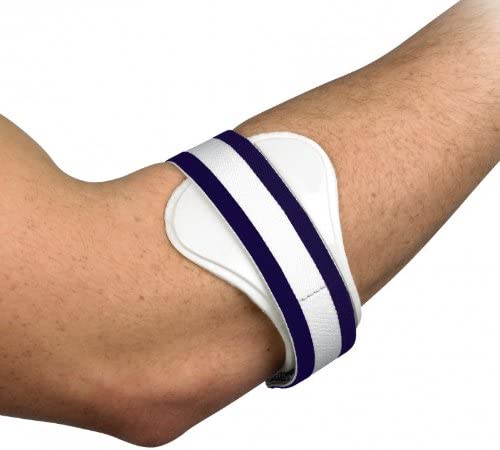Golfer's elbow
WHAT IS GOLFER'S ELBOW?The medical term for Golfer’s Elbow is Medial Epicondylitis. It is not just golfers that suffer from this condition. Any activity that involves repetitive activity of the forearm can lead to golfer's elbow: throwing, chopping wood with an axe and using many types of hand tools. Just as with tennis elbow (lateral epicondylitis), this is not thought to be inflammatory condition but is more of a degenerative one, ie it is caused by wear and tear (microtrauma) to the tendon-bone junction.
It is a self-limiting condition which means it will usually resolve itself, given time, even if you do nothing at all about it. The trouble is, this is not usually within a reasonable time-frame for the patient who is trying to carry on with their life’s activities.
WHAT PARTS OF THE ELBOW ARE AFFECTED?Golfer's elbow causes pain on the inside part of the elbow where the muscles that flex the wrist attach. It can also cause pain that radiates down the forearm. The muscle attaches to the bone via a tendon called the common flexor tendon. The flexor muscles bend your wrist up and provide grip strength.
WHAT CAUSES MEDICAL EPICONDYLITIS?This is really an overuse injury caused by microtrauma at the bone-tendon interface. The tendon undergoes multiple small tears which don’t get the chance to repair fully before tearing again. Scar tissue builds up with an increasingly avascular (poor blood supply) area. This build-up of affected tissue gives the symptoms. Causes are varied and often not necessarily identifiable but usually involve repetitive activity rather than heavy loads.
WHAT ARE THE SYMPTOMS OF MEDIAL EPICONDYLITIS?The main symptom is pain at the medial epicondyle of the elbow. Pain usually starts at the medial epicondyle and spreads down the forearm. Activities such as bending your wrist or gripping tightly will make the pain worse.
HOW IS IT DIAGNOSED?Your surgeon will take a detailed history and then perform a careful examination to see if your symptoms and signs are in-keeping with medial epicondylitis.
They should ask about how your pain affects you, your regular activities and past injuries to your elbow. The physical exam is usually helpful in confirming or excluding golfer's elbow. If the diagnosis is not clear, your surgeon may request a scan to help find the cause.
 WHAT IS THE TREATMENT?NONSURGICAL TREATMENT:The goal of treatment is to break the vicious circle of trauma and scarring that has led to the problem. This can be difficult and there is no one, proven, excellent treatment unfortunately. Anti-inflammatory medications may help as there is usually an element of inflammation going on. Your doctor or surgeon may suggest an injection into the area with steroid to calm down an inflammatory reaction. This may help but if it is of limited benefit, repeated injections are unlikely to work. Indeed, no one should have repeated injections since steroid has a side-effect of causing skin thinning and this makes other treatments difficult. You may be offered physiotherapy which, if properly directed, can help enormously. You may be offered a clasp which is a band worn just down from the elbow. This aims to transfer the pull of the muscle on the tendon to a slightly different place and rest the tendon whilst, hopefully, healing takes place. The clasps can be purchased easily and inexpensively online at, for example amazon.co.uk, by searching 'tennis elbow clasp'. It is the same clasp used in both tennis and golfer's elbow. Also important is checking that your technique is correct if you are performing sporting activity, as sometimes adjusting the technique can ease the problem. For example changing your grip on your racket might help.
SURGICAL TREATMENT:Sometimes nonsurgical treatment fails to relieve the symptoms sufficiently to return to normal activity stop the pain or help patients regain use of the elbow. In these cases, surgery may be recommended. This involves a general anaesthetic (usually). A cut is made over the medial epicondyle and the tendon is exposed beneath. The tendon is split and any scar tissue that has formed in the tendon is removed. Bleeding is encouraged as this brings new vessel formation and oxygenated blood to the area to assist the healing process. Your elbow may be protected in a cast for a couple of weeks afterwards to allow the tendon to heal and allow the wound to heal.
Spire Elland HospitalElland Lane
Elland
HX5 9EB
For an appointment, telephone:
Clinic bookings on 01422 324 069
Self pay enquiries on 01422 229 597
Main Hospital on 01422 229 632
BMI The Huddersfield Hospital
Birkby Hall Road
Huddersfield
West Yorkshire
HD2 2BL
Reception: 01484 533 131
Department of Orthopaedics & Trauma
Calderdale and Huddersfield NHS Foundation Trust
Huddersfield Royal Infirmary
Acre Street
Lindley
Huddersfield
HD3 3EA
NHS Secretary:
Mrs Margaret Thomas
Tel 01484 342 343
NHS Clinics Trauma:
Calderdale Royal Hospital (Halifax) and
Huddersfield Royal Infirmary
Elective Shoulder and Elbow problems:
Friday morning at Calderdale Royal Hospital, Halifax
|